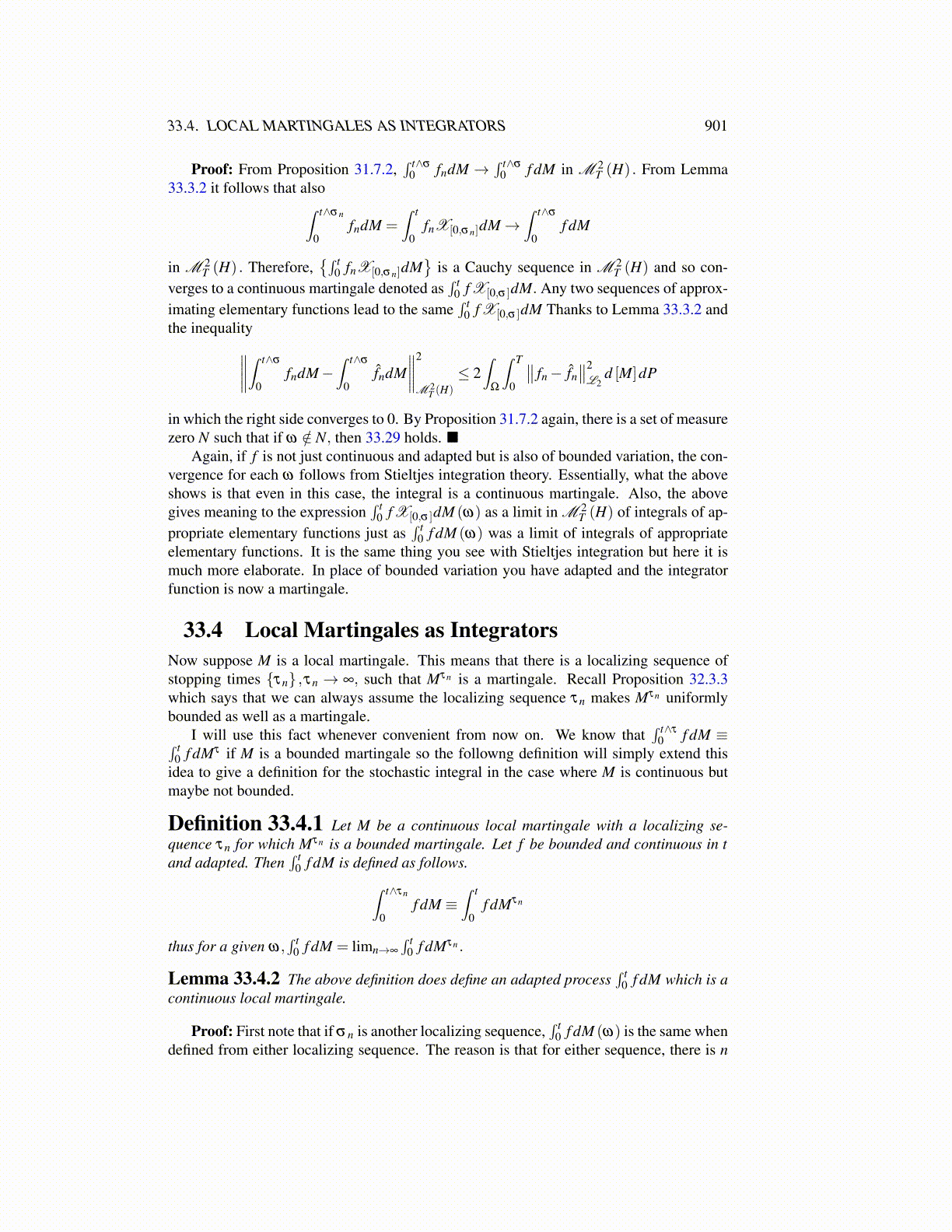
33.4. LOCAL MARTINGALES AS INTEGRATORS 901
Proof: From Proposition 31.7.2,∫ t∧σ
0 fndM →∫ t∧σ
0 f dM in M 2T (H) . From Lemma
33.3.2 it follows that also∫ t∧σn
0fndM =
∫ t
0fnX[0,σn]dM→
∫ t∧σ
0f dM
in M 2T (H) . Therefore,
{∫ t0 fnX[0,σn]dM
}is a Cauchy sequence in M 2
T (H) and so con-verges to a continuous martingale denoted as
∫ t0 f X[0,σ ]dM. Any two sequences of approx-
imating elementary functions lead to the same∫ t
0 f X[0,σ ]dM Thanks to Lemma 33.3.2 andthe inequality∥∥∥∥∫ t∧σ
0fndM−
∫ t∧σ
0f̂ndM
∥∥∥∥2
M 2T (H)
≤ 2∫
Ω
∫ T
0
∥∥ fn− f̂n∥∥2
L2d [M]dP
in which the right side converges to 0. By Proposition 31.7.2 again, there is a set of measurezero N such that if ω /∈ N, then 33.29 holds. ■
Again, if f is not just continuous and adapted but is also of bounded variation, the con-vergence for each ω follows from Stieltjes integration theory. Essentially, what the aboveshows is that even in this case, the integral is a continuous martingale. Also, the abovegives meaning to the expression
∫ t0 f X[0,σ ]dM (ω) as a limit in M 2
T (H) of integrals of ap-propriate elementary functions just as
∫ t0 f dM (ω) was a limit of integrals of appropriate
elementary functions. It is the same thing you see with Stieltjes integration but here it ismuch more elaborate. In place of bounded variation you have adapted and the integratorfunction is now a martingale.
33.4 Local Martingales as IntegratorsNow suppose M is a local martingale. This means that there is a localizing sequence ofstopping times {τn} ,τn → ∞, such that Mτn is a martingale. Recall Proposition 32.3.3which says that we can always assume the localizing sequence τn makes Mτn uniformlybounded as well as a martingale.
I will use this fact whenever convenient from now on. We know that∫ t∧τ
0 f dM ≡∫ t0 f dMτ if M is a bounded martingale so the followng definition will simply extend this
idea to give a definition for the stochastic integral in the case where M is continuous butmaybe not bounded.
Definition 33.4.1 Let M be a continuous local martingale with a localizing se-quence τn for which Mτn is a bounded martingale. Let f be bounded and continuous in tand adapted. Then
∫ t0 f dM is defined as follows.∫ t∧τn
0f dM ≡
∫ t
0f dMτn
thus for a given ω,∫ t
0 f dM = limn→∞
∫ t0 f dMτn .
Lemma 33.4.2 The above definition does define an adapted process∫ t
0 f dM which is acontinuous local martingale.
Proof: First note that if σn is another localizing sequence,∫ t
0 f dM (ω) is the same whendefined from either localizing sequence. The reason is that for either sequence, there is n